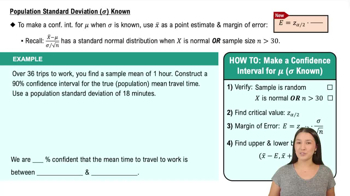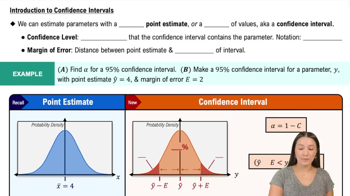You ask 16 people in your Statistics class what their grade is. The data appears to be distributed normally. You find a sample mean and sample standard deviation of 60 and 24, respectively. Construct and interpret a 95% confidence interval for the population mean class grade.
Table of contents
- 1. Intro to Stats and Collecting Data1h 14m
- 2. Describing Data with Tables and Graphs1h 55m
- 3. Describing Data Numerically2h 5m
- 4. Probability2h 16m
- 5. Binomial Distribution & Discrete Random Variables3h 6m
- 6. Normal Distribution and Continuous Random Variables2h 11m
- 7. Sampling Distributions & Confidence Intervals: Mean3h 23m
- Sampling Distribution of the Sample Mean and Central Limit Theorem19m
- Distribution of Sample Mean - Excel23m
- Introduction to Confidence Intervals15m
- Confidence Intervals for Population Mean1h 18m
- Determining the Minimum Sample Size Required12m
- Finding Probabilities and T Critical Values - Excel28m
- Confidence Intervals for Population Means - Excel25m
- 8. Sampling Distributions & Confidence Intervals: Proportion1h 12m
- 9. Hypothesis Testing for One Sample3h 29m
- 10. Hypothesis Testing for Two Samples4h 50m
- Two Proportions1h 13m
- Two Proportions Hypothesis Test - Excel28m
- Two Means - Unknown, Unequal Variance1h 3m
- Two Means - Unknown Variances Hypothesis Test - Excel12m
- Two Means - Unknown, Equal Variance15m
- Two Means - Unknown, Equal Variances Hypothesis Test - Excel9m
- Two Means - Known Variance12m
- Two Means - Sigma Known Hypothesis Test - Excel21m
- Two Means - Matched Pairs (Dependent Samples)42m
- Matched Pairs Hypothesis Test - Excel12m
- 11. Correlation1h 6m
- 12. Regression1h 50m
- 13. Chi-Square Tests & Goodness of Fit1h 57m
- 14. ANOVA1h 57m
7. Sampling Distributions & Confidence Intervals: Mean
Confidence Intervals for Population Mean
Problem 7.2.34b
Textbook Question
Finite Population Correction Factor If a simple random sample of size n is selected without replacement from a finite population of size (n>0.05N), and the sample size is more than 5% of the population size , better results can be obtained by using the finite population correction factor, which involves multiplying the margin of error E by [Image]. Refer to the weights of the M&M candies in Data Set 38 “Candies” in Appendix B.
b. Use only the red M&Ms and treat that sample as a simple random sample selected from the population of the 345 M&Ms listed in the data set. Find the 95% confidence interval estimate of the mean weight of all 345 M&Ms. Compare the result to the actual mean of the population of all 345 M&Ms.
 Verified step by step guidance
Verified step by step guidance1
Step 1: Identify the given values and conditions. From the problem, the population size (N) is 345, and the sample size (n) is such that n > 0.05N, meaning the sample size is more than 5% of the population. This condition necessitates the use of the finite population correction factor.
Step 2: Recall the formula for the finite population correction factor (FPCF), which is: \( \sqrt{\frac{N - n}{N - 1}} \). Here, N is the population size, and n is the sample size. This factor will be used to adjust the margin of error.
Step 3: Calculate the margin of error (E) for the confidence interval. The formula for E is: \( E = z \cdot \frac{s}{\sqrt{n}} \), where z is the z-score corresponding to the 95% confidence level (typically 1.96), s is the sample standard deviation, and n is the sample size. Compute this value first without applying the correction factor.
Step 4: Adjust the margin of error using the finite population correction factor. Multiply the previously calculated margin of error (E) by the correction factor \( \sqrt{\frac{N - n}{N - 1}} \). This gives the corrected margin of error.
Step 5: Construct the 95% confidence interval for the mean weight of the M&Ms. The formula is: \( \text{Confidence Interval} = \bar{x} \pm E \), where \( \bar{x} \) is the sample mean and E is the corrected margin of error. Compare the resulting confidence interval to the actual mean of the population to evaluate the accuracy of the estimate.
 Verified video answer for a similar problem:
Verified video answer for a similar problem:This video solution was recommended by our tutors as helpful for the problem above
Video duration:
6mPlay a video:
Was this helpful?
Key Concepts
Here are the essential concepts you must grasp in order to answer the question correctly.
Finite Population Correction Factor
The Finite Population Correction Factor (FPC) is used when sampling without replacement from a finite population. It adjusts the margin of error to account for the reduced variability in the sample when a significant portion of the population is sampled. Specifically, when the sample size exceeds 5% of the population, the FPC helps provide a more accurate estimate of the population parameters.
Recommended video:

Population Standard Deviation Known
Confidence Interval
A confidence interval is a range of values, derived from sample statistics, that is likely to contain the true population parameter with a specified level of confidence, typically 95%. It is calculated using the sample mean, the standard error, and a critical value from the normal distribution. This interval provides insight into the precision of the sample estimate and the uncertainty associated with it.
Recommended video:

Introduction to Confidence Intervals
Simple Random Sampling
Simple random sampling is a fundamental sampling technique where each member of the population has an equal chance of being selected. This method ensures that the sample is representative of the population, minimizing bias. In the context of the question, treating the selected red M&Ms as a simple random sample allows for valid statistical inferences about the mean weight of all M&Ms in the population.
Recommended video:

Sampling Distribution of Sample Proportion

 4:48m
4:48mWatch next
Master Population Standard Deviation Known with a bite sized video explanation from Patrick
Start learningRelated Videos
Related Practice
Multiple Choice
